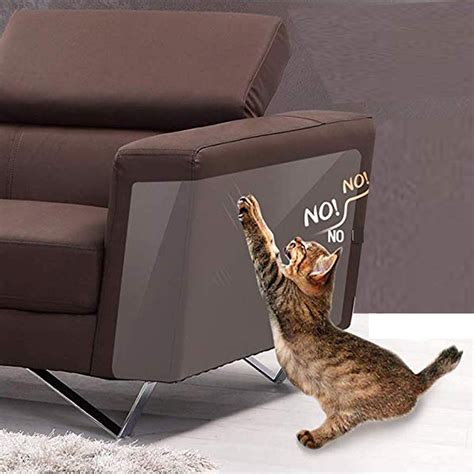Cats are beloved pets, but their scratching habits can wreak havoc on furniture. Striking a balance between protecting your furniture and providing your cat with a healthy outlet for its scratching needs is crucial.

Understanding Cat Scratching
Cats scratch for various reasons, including:
- Mark territory: Scratch marks release pheromones that communicate territorial claims.
- Remove old nail sheaths: Scratching helps remove dead outer nail sheaths, exposing sharper claws.
- Stress relief: Scratching can be a calming activity for stressed cats.
- Exercise: Scratching provides physical and mental stimulation.
Furniture Protection: The Battleground
Furniture is often a victim of cat scratching, causing damage and frustration for owners. Here are some common pain points:
- Scratched upholstery: Upholstered furniture, such as sofas and chairs, is particularly vulnerable to scratching.
- Damaged wood: Wooden furniture, including tables and cabinets, can be scratched and gouged.
- Ripped fabric: Curtains, blinds, and other fabric items can be easily torn by scratching cats.
The Quest for a Solution: Cat Scratching and Furniture Protection
Balancing cat scratching and furniture protection requires a multifaceted approach:
Step 1: Provide Scratching Alternatives
Offering your cat designated scratching surfaces is crucial. Consider these options:
- Sisal scratching posts: Sisal’s rope-like texture mimics tree bark, making it an attractive scratching surface.
- Cardboard scratchers: Cardboard is another popular choice that allows cats to sharpen their claws and remove old sheaths.
- Furniture protectors: Scratch-resistant fabrics or adhesive protectors can be applied to furniture to deter scratching.
Step 2: Encourage Scratching on Alternatives
Make the scratching alternatives appealing by:
- Placing them in strategic locations: Offer scratchers near areas where your cat frequently scratches, such as furniture corners or window perches.
- Rubbing catnip on the scratcher: Catnip can entice cats to use the scratcher.
- Rewarding your cat: Praise or treats can reinforce positive scratching behavior.
Step 3: Discourage Scratching on Furniture
While providing alternatives is essential, discouraging scratching on furniture is equally crucial:
- Avoid punishing your cat: Punishing a cat for scratching only creates fear and anxiety. Instead, focus on redirecting the behavior.
- Use deterrents: Citrus scents or other unpleasant smells can deter cats from scratching on furniture.
- Trim your cat’s claws: Regular claw trims can reduce the damage caused by scratching.
Step 4: Identify and Address Underlying Causes
If your cat exhibits excessive scratching, it may be a symptom of an underlying issue, such as stress, anxiety, or a medical condition. Address these issues to reduce the need for destructive scratching.
Comparing Approaches: Declawing vs. Non-Surgical Solutions
Declawing, the surgical removal of a cat’s claws, was once a common procedure. However, ethical concerns and potential complications have led to a shift towards non-surgical solutions.
| Approach | Pros | Cons |
|---|---|---|
| Declawing | Prevents furniture damage | Can cause chronic pain, behavioral problems, and mobility issues |
| Non-surgical solutions | Humane, preserves natural instincts | Requires consistency and effort, may not always be 100% effective |
FAQs on Cat Scratching and Furniture Protection
- Why does my cat scratch furniture?
- Are there any effective deterrents for furniture scratching?
- Is declawing a viable solution?
- How can I encourage my cat to use a scratching post?
- What are some alternatives to declawing?
- Can I repair scratched furniture?
- How can I prevent my cat from scratching new furniture?
- Is it ok to redirect my cat’s scratching behavior to a specific area?
Future Trends: Identifying New Solutions
Research into cat scratching behavior and furniture protection is ongoing. Some promising trends include:
- Scratching furniture with innovative materials: Materials that mimic the texture and feel of natural scratching surfaces may provide superior protection.
- Cat-friendly deterrents: Natural or synthetic substances that deter cats from scratching without causing harm or discomfort.
- Behavioral modification techniques: Advanced training methods to effectively redirect scratching behavior and reinforce desired outcomes.
Conclusion
Cat scratching is a natural behavior that can pose challenges for furniture protection. By understanding the reasons behind scratching, providing alternatives, discouraging scratching on furniture, and addressing underlying issues, you can strike a balance between your cat’s well-being and the integrity of your home furnishings. Embrace innovative solutions and stay informed about the latest advancements to ensure ultimate harmony between your feline companion and your furniture.





















